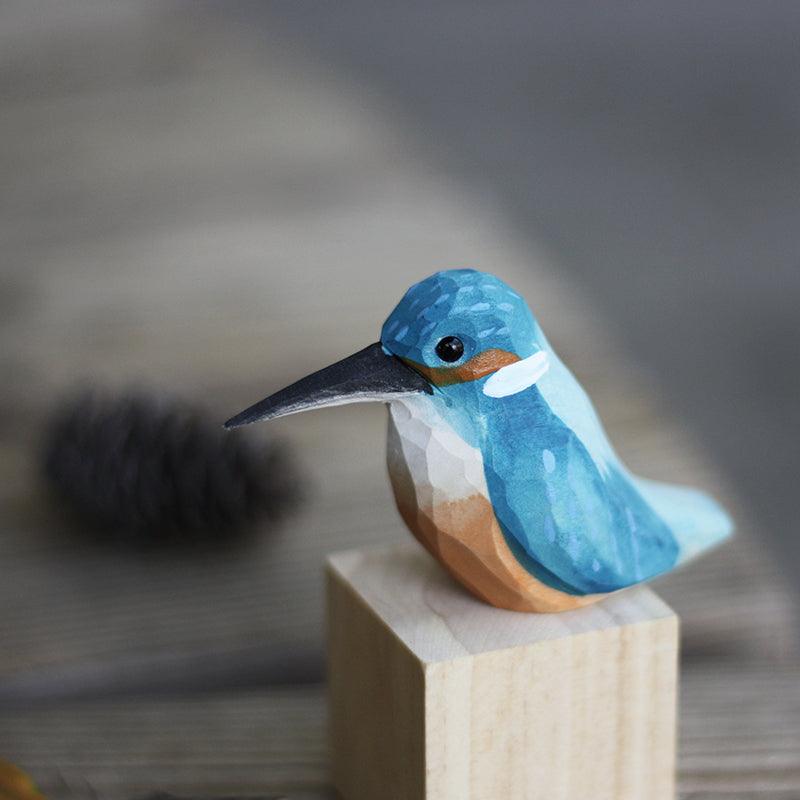
The Remarkable Beak of the Kingfisher: Nature's Precision Tool
Share
The Kingfisher's Signature Feature
 The kingfisher is one of nature's most striking birds, known for its vibrant plumage, sharp eyesight, and, most notably, its distinctive beak. This beak is not just a simple tool for feeding; it is a marvel of evolutionary design, perfectly suited to the kingfisher's hunting style and habitat. In this blog, we explore the unique characteristics and functions of the kingfisher's beak, and how it has made this bird one of the most efficient hunters in the avian world.
The kingfisher is one of nature's most striking birds, known for its vibrant plumage, sharp eyesight, and, most notably, its distinctive beak. This beak is not just a simple tool for feeding; it is a marvel of evolutionary design, perfectly suited to the kingfisher's hunting style and habitat. In this blog, we explore the unique characteristics and functions of the kingfisher's beak, and how it has made this bird one of the most efficient hunters in the avian world.
A Beak Designed for Precision
The kingfisher’s beak is long, straight, and pointed, resembling a spear. This shape is no accident; it is perfectly adapted to the bird’s primary hunting method—diving headfirst into water to catch fish. The beak’s streamlined shape allows the kingfisher to cut through water with minimal resistance, enabling it to catch prey with remarkable speed and accuracy.
Unlike many other birds, the kingfisher’s beak is also quite robust, capable of withstanding the impact of hitting the water at high speeds. This durability is essential for a bird that relies on such a dramatic hunting technique.
Adaptations for Aquatic Hunting
The kingfisher’s beak is specifically adapted to its diet, which mainly consists of fish and aquatic invertebrates. The sharp point and strong structure allow the kingfisher to grasp slippery prey securely. When a kingfisher spots a fish, it will dive from a perch or hover above the water, then plunge down with its beak leading the way, striking the fish with pinpoint accuracy.
The shape of the beak also helps the kingfisher to reduce the splash when entering the water, which could otherwise alert prey and make hunting more difficult. This adaptation is crucial for a bird that often hunts in clear, still waters where any disturbance could scare away potential food.
The Beak as a Multi-Tool
While the primary function of the kingfisher’s beak is hunting, it also serves several other important purposes. For instance, the beak is used for grooming and maintaining the bird’s feathers, which is essential for keeping them waterproof—a critical factor for a bird that spends so much time diving into water.
Additionally, the beak is used in courtship displays and territorial defense. During mating season, male kingfishers may present fish to potential mates as a part of their courtship ritual, and the beak plays a key role in this behavior. The beak is also used to fend off rivals and protect the bird’s territory from intruders.
Variation Among Kingfisher Species
There are over 90 species of kingfishers, and while all share the basic beak design, there is some variation depending on their specific habitat and diet. For example, the beak of the Common Kingfisher, which primarily hunts fish, is slender and perfectly streamlined. In contrast, the beak of the Woodland Kingfisher, which feeds on insects and small reptiles, is broader and slightly more curved, reflecting its different dietary needs.
These variations in beak shape and size highlight the adaptability of kingfishers to different environments and food sources, demonstrating how evolution has fine-tuned this feature to suit the specific needs of each species.
Cultural Significance of the Kingfisher's Beak
In many cultures, the kingfisher is seen as a symbol of precision, patience, and agility—all qualities that are embodied in its beak. The bird’s ability to catch fish with such skill and efficiency has made it a symbol of keen vision and determination.
In some cultures, the kingfisher’s beak is also associated with luck and prosperity, as the bird is often seen as a bringer of good fortune due to its success in hunting and its vibrant appearance.
Nature's Precision Instrument
The beak of the kingfisher is more than just a tool for catching food; it is a remarkable example of how evolution can shape an organism to thrive in its environment. From its streamlined design to its strength and versatility, the kingfisher’s beak is a true masterpiece of nature’s engineering. As we continue to study and admire these incredible birds, the kingfisher’s beak stands out as a symbol of the delicate balance between form and function in the natural world.







